
By the end of this section, you will be able to:
Discuss the contributions of Abraham Maslow and Carl Rogers to personality development
- Material Type:
- Module
- Date Added:
- 09/20/2018

By the end of this section, you will be able to:
Discuss the contributions of Abraham Maslow and Carl Rogers to personality development

In this module, students learn about translations, reflections, and rotations in the plane and, more importantly, how to use them to precisely define the concept of congruence. Throughout Topic A, on the definitions and properties of the basic rigid motions, students verify experimentally their basic properties and, when feasible, deepen their understanding of these properties using reasoning. All the lessons of Topic B demonstrate to students the ability to sequence various combinations of rigid motions while maintaining the basic properties of individual rigid motions. Students learn that congruence is just a sequence of basic rigid motions in Topic C, and Topic D begins the learning of Pythagorean Theorem.
Find the rest of the EngageNY Mathematics resources at https://archive.org/details/engageny-mathematics.

This lesson [2:00] will define the phrase corresponding parts (e.g. angles, sides, etc.). It is 1 of 5 in the series titled "Corresponding Parts."
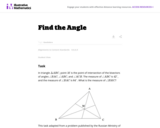
This task requires students to find the measure of an angle.
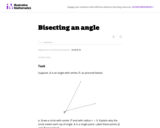
This task provides the most famous construction to bisect a given angle. It applies when the angle is not 180 degrees.
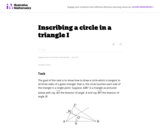
This task shows how to inscribe a circle in a triangle using angle bisectors. A companion task, ``Inscribing a circle in a triangle II'' stresses the auxiliary remarkable fact that comes out of this task, namely that the three angle bisectors of triangle ABC all meet in the point O.

Students, teachers, and parents alike will enjoy this challenging math site. It contains a clever brain teaser section plus creative problems related to algebra, geometry, measurement, numbers, statistics, and probability. A Spanish version is available.

(Nota: Esta es una traducción de un recurso educativo abierto creado por el Departamento de Educación del Estado de Nueva York (NYSED) como parte del proyecto "EngageNY" en 2013. Aunque el recurso real fue traducido por personas, la siguiente descripción se tradujo del inglés original usando Google Translate para ayudar a los usuarios potenciales a decidir si se adapta a sus necesidades y puede contener errores gramaticales o lingüísticos. La descripción original en inglés también se proporciona a continuación.)
Así como se utilizan movimientos rígidos para definir la congruencia en el Módulo 1, se agregan dilataciones para definir la similitud en el Módulo 2. Para poder discutir la similitud, los estudiantes primero deben comprender claramente cómo se comportan las dilataciones. Esto se hace en dos partes, al estudiar cómo las dilataciones producen dibujos de escala y razonando por qué las propiedades de las dilataciones deben ser ciertas. Una vez que las dilataciones se establecen claramente, se definen transformaciones de similitud y se examinan las relaciones de longitud y ángulo, lo que produce criterios de similitud triangular. Sigue una mirada profunda a la similitud dentro de los triángulos rectos, y finalmente el módulo termina con un estudio de trigonometría del triángulo recto.
Encuentre el resto de los recursos matemáticos de Engageny en https://archive.org/details/engageny-mathematics.
English Description:
Just as rigid motions are used to define congruence in Module 1, so dilations are added to define similarity in Module 2. To be able to discuss similarity, students must first have a clear understanding of how dilations behave. This is done in two parts, by studying how dilations yield scale drawings and reasoning why the properties of dilations must be true. Once dilations are clearly established, similarity transformations are defined and length and angle relationships are examined, yielding triangle similarity criteria. An in-depth look at similarity within right triangles follows, and finally the module ends with a study of right triangle trigonometry.
Find the rest of the EngageNY Mathematics resources at https://archive.org/details/engageny-mathematics.

(Nota: Esta es una traducción de un recurso educativo abierto creado por el Departamento de Educación del Estado de Nueva York (NYSED) como parte del proyecto "EngageNY" en 2013. Aunque el recurso real fue traducido por personas, la siguiente descripción se tradujo del inglés original usando Google Translate para ayudar a los usuarios potenciales a decidir si se adapta a sus necesidades y puede contener errores gramaticales o lingüísticos. La descripción original en inglés también se proporciona a continuación.)
El módulo 1 incorpora cambios críticos en la geometría según lo descrito por el núcleo común. El corazón del módulo es el estudio de las transformaciones y el papel que juegan las transformaciones para definir la congruencia. El tema de las transformaciones se introduce de manera principalmente experiencial en el grado 8 y se formaliza en el grado 10 con el uso de un lenguaje preciso. La necesidad de un uso claro del lenguaje se enfatiza a través del vocabulario, el proceso de escribir pasos para realizar construcciones y, en última instancia, como parte del proceso de escritura de prueba.
Encuentre el resto de los recursos matemáticos de Engageny en https://archive.org/details/engageny-mathematics.
English Description:
Module 1 embodies critical changes in Geometry as outlined by the Common Core. The heart of the module is the study of transformations and the role transformations play in defining congruence. The topic of transformations is introduced in a primarily experiential manner in Grade 8 and is formalized in Grade 10 with the use of precise language. The need for clear use of language is emphasized through vocabulary, the process of writing steps to perform constructions, and ultimately as part of the proof-writing process.
Find the rest of the EngageNY Mathematics resources at https://archive.org/details/engageny-mathematics.

Module 1 embodies critical changes in Geometry as outlined by the Common Core. The heart of the module is the study of transformations and the role transformations play in defining congruence. The topic of transformations is introduced in a primarily experiential manner in Grade 8 and is formalized in Grade 10 with the use of precise language. The need for clear use of language is emphasized through vocabulary, the process of writing steps to perform constructions, and ultimately as part of the proof-writing process.
Find the rest of the EngageNY Mathematics resources at https://archive.org/details/engageny-mathematics.

This lesson [4:27] will define the phrase corresponding parts (e.g. angles, sides, etc.). It is 2 of 5 in the series titled "Corresponding Parts."
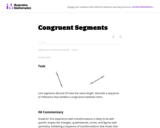
Students' first experience with transformations is likely to be with specific shapes like triangles, quadrilaterals, circles, and figures with symmetry. Exhibiting a sequence of transformations that shows that two generic line segments of the same length are congruent is a good way for students to begin thinking about transformations in greater generality.
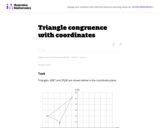
This task gives students a chance to explore several issues relating to rigid motions of the plane and triangle congruence. As an instructional task, it can help students build up their understanding of the relationship between rigid motions and congruence.
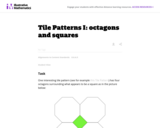
This task aims at explaining why four regular octagons can be placed around a central square, applying student knowledge of triangles and sums of angles in both triangles and more general polygons.
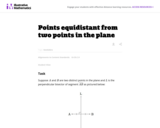
This task is part of a series presenting important foundational geometric results and constructions which are fundamental for more elaborate arguments. They are presented without a real world context so as to see the important hypotheses and logical steps involved as clearly as possible.

This module brings together the ideas of similarity and congruence and the properties of length, area, and geometric constructions studied throughout the year. It also includes the specific properties of triangles, special quadrilaterals, parallel lines and transversals, and rigid motions established and built upon throughout this mathematical story. This module's focus is on the possible geometric relationships between a pair of intersecting lines and a circle drawn on the page.
Find the rest of the EngageNY Mathematics resources at https://archive.org/details/engageny-mathematics.
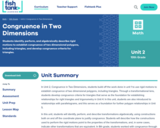
Students identify, perform, and algebraically describe rigid motions to establish congruence of two dimensional polygons, including triangles, and develop congruence criteria for triangles.

Video tutorial explores the term congruent which is often used to describe figures that have the same size and shape. [5:21]
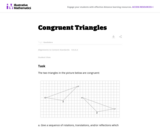
This task has two goals: first to develop student understanding of rigid motions in the context of demonstrating congruence. Secondly, student knowledge of reflections is refined by considering the notion of orientation in part (b).
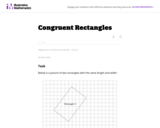
This task is designed to give students insight into the effects of translations, rotations, and reflections on geometric figures in the context of showing that two figures are congruent.